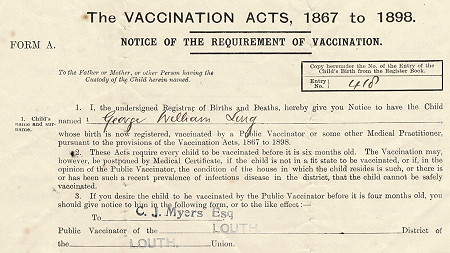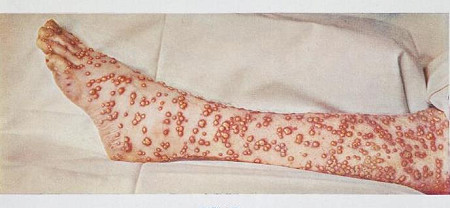Vaccination against smallpox

Beginning of vaccination document

Smallpox pustules. Photo Wellcome Foundation
While sorting through the backlog of items in the museum, we came across a document, dated 1907, inviting the parents of baby George William Ling to arrange for him to be vaccinated against smallpox. The form had been given out by the Registrar of Birth and Deaths in Louth.
Smallpox was a highly infectious disease caused by a virus. It caused blindness and infertility, and was often fatal in children. In the 1790s Dr Edward Jenner had developed a method of vaccination against smallpox, and the Vaccination Act of 1853 made it compulsory for all babies to be vaccinated.
Today people can be vaccinated against a whole host of infectious diseases, but smallpox is not one of them. Thanks to a global programme of mass vaccination, the world was officially free of this killer disease by 1979.
Usually, the public vaccinator visited the baby in its own home. In 1907 the public vaccinator in Louth was Charles John Myers, a doctor who lived in Eastgate House. George William was the son of coachman William Ling and his wife Annie, and they lived in 14 Eastfield Road, a terraced cottage not far from the doctor’s house.
On our 1907 form, one of the later sections was intended for recording when the baby was vaccinated, but this remains blank. I did wonder if baby George William had died before he could be vaccinated, but this was not the case as newspaper reports show that he became a gas fitter and was a marshall at Cadwell Park; he died in 1981 and was buried in Louth Cemetery.
Possibly William and Annie Ling had simply lost the original form that they had been given, and if so, presumably the doctor provided a replacement. On the other hand, was this an early 20th century example of what we now call “vaccine hesitancy”? Under the 1898 Vaccination Act parents could opt out as “conscientious objectors” instead of being fined, but lack of a vaccination certificate would have led to major problems in obtaining work.